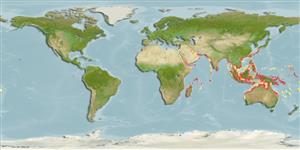>
Eupercaria/misc (Various families in series Eupercaria) >
Sciaenidae (Drums or croakers)
Eponymy: Rev Dr Christoph Samuel John (1747–1813) was a botanist and herpetologist and a medical missionary (1771–1813) at the Danish trading station of Tranquebar (now Tharangambadi), Tamil Nadu, not far from Madras (Chennai). [...] (Ref. 128868), visit book page.
Environment: milieu / climate zone / rango de profundidad / distribution range
Ecología
marino bentopelágico. Tropical
Indo-Pacific: India and Sri Lanka to the South China Sea, Borneo and the Malay Peninsula.
Tamaño / Peso / Age
Madurez: Lm ? range ? - ? cm
Max length : 30.0 cm SL macho / no sexado; (Ref. 9772); common length : 22.0 cm SL macho / no sexado; (Ref. 9772); edad máxima reportada: 5 años (Ref. 72458)
Espinas dorsales (total) : 11; Radios blandos dorsales (total) : 27 - 30; Espinas anales: 2; Radios blandos anales: 7. Lower part of body with a golden tinge; pectoral, pelvic and anal fins yellow; a faint steel blue blotch on gill cover (Ref. 9772).
Body shape (shape guide): fusiform / normal.
Inhabits shallow coastal waters (Ref. 9772).
Life cycle and mating behavior
Madurez | Reproducción | Puesta | Huevos | Fecundidad | Larva
Sasaki, K., 2001. Sciaenidae. Croakers (drums). p.3117-3174. In K.E. Carpenter and V.H. Niem (eds.) FAO species identification guide for fishery purposes. The living marine resources of the Western Central Pacific. Volume 5. Bony fishes part 3 (Menidae to Pomacentridae). Rome, FAO. pp. 2791-3380. (Ref. 9772)
IUCN Red List Status (Ref. 130435: Version 2025-1)
Threat to humans
Harmless
Human uses
Pesquerías: escaso valor comercial
Herramientas
Special reports
Download XML
Fuentes de Internet
Estimates based on models
Preferred temperature (Referencia
123201): 24.9 - 29.1, mean 28.3 °C (based on 958 cells).
Phylogenetic diversity index (Referencia
82804): PD
50 = 0.5000 [Uniqueness, from 0.5 = low to 2.0 = high].
Bayesian length-weight: a=0.00759 (0.00468 - 0.01229), b=3.06 (2.93 - 3.19), in cm total length, based on LWR estimates for this species & Genus-body shape (Ref.
93245).
Nivel trófico (Referencia
69278): 3.5 ±0.4 se; based on size and trophs of closest relatives
Resiliencia (Referencia
120179): Medio, población duplicada en un tiempo mínimo de 1.4-4.4 años (K=0.5-0.8; tmax=5).
Fishing Vulnerability (Ref.
59153): Low vulnerability (22 of 100).
🛈
